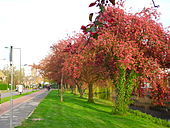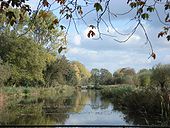- Delft
-
Delft — Municipality — 
Flag
Coat of armsCoordinates: 52°0′54″N 4°21′24″E / 52.015°N 4.35667°ECoordinates: 52°0′54″N 4°21′24″E / 52.015°N 4.35667°E Country Netherlands Province South Holland Area(2006) – Total 24.08 km2 (9.3 sq mi) – Land 23.21 km2 (9 sq mi) – Water 0.87 km2 (0.3 sq mi) Population (1 January 2008) – Total 96,168 – Density 4,180/km2 (10,826.2/sq mi) Source: CBS, Statline. Time zone CET (UTC+1) – Summer (DST) CEST (UTC+2) Delft (
 pronunciation (help·info)) is a city and municipality in the province of South Holland (Zuid-Holland), the Netherlands. It is located between Rotterdam and The Hague. Delft is primarily known for its typically Dutch town centre (with canals); also for the painter Vermeer, Delft Blue pottery (Delftware), the Delft University of Technology, and its association with the Dutch royal family, the House of Orange-Nassau.
pronunciation (help·info)) is a city and municipality in the province of South Holland (Zuid-Holland), the Netherlands. It is located between Rotterdam and The Hague. Delft is primarily known for its typically Dutch town centre (with canals); also for the painter Vermeer, Delft Blue pottery (Delftware), the Delft University of Technology, and its association with the Dutch royal family, the House of Orange-Nassau.Contents
History
From a rural village in the early Middle Ages Delft developed to a city, that in the 13th century (1246) received its charter.
(For some more information about the early developement, see the article "Gracht", section "Delft as an example").The town's association with the House of Orange started when William of Orange (Willem van Oranje), nicknamed William the Silent (Willem de Zwijger), took up residence in 1572 At the time he was the leader of growing national Dutch resistance against Spanish occupation of the country, which struggle is known as the Eighty Years' War. By then Delft was one of the leading cities of Holland and it was equipped with the necessary city walls to serve as a headquarters.
After the Act of Abjuration was proclaimed in 1581 Delft became the de facto capital of the newly independent Netherlands, as the seat of the Prince of Orange.
When William was shot dead in 1584, by Balthazar Gerards in the hall of the Prinsenhof, the family's traditional burial place in Breda was still in the hands of the Spanish. Therefore, he was buried in the Delft Nieuwe Kerk (New Church), starting a tradition for the House of Orange that has continued to the present day.
Delft Explosion
The Delft Explosion, also known in history as the Delft Thunderclap, occurred on 12 October 1654 when a gunpowder store exploded, destroying much of the city. Over a hundred people were killed and thousands wounded.
About 30 tonnes of gunpowder were stored in barrels in a magazine in a former Clarissen convent in the Doelenkwartier district. Cornelis Soetens, the keeper of the magazine, opened the store to check a sample of the powder and a huge explosion followed. Luckily, many citizens were away, visiting a market in Schiedam or a fair in The Hague. Artist Carel Fabritius was wounded in the explosion and died of his injuries. Later on, Egbert van der Poel painted several pictures of Delft showing the devastation. The Delft Explosion is the principal reason why Delft University of Technology maintains explosion science as a key topic within its research portfolio and graduate skill-set.
Sights
The city center retains a large number of monumental buildings, whereas in many streets there are canals of which the borders are connected by typical bridges,[1] altogether making this city a notable tourist destination.
Historical buildings include:
- Oude Kerk (Old Church). Buried here: Piet Hein, Johannes Vermeer, Anthony van Leeuwenhoek.
- Nieuwe Kerk (New Church), constructed between 1381 and 1496. It contains the Dutch royal family's burial vault, which between funerals is sealed with a 5000 kg cover stone.
- The Prinsenhof (Princes' Court), now a museum.
- City Hall on the Markt.
- The Oostpoort (Eastern gate), built around 1400. This is the only remaining gate of the old city walls.
- The Gemeenlandshuis Delfland, or Huyterhuis, built in 1505, which houses the regional water authority Delfland since 1645.
- Waag (Delft)
Culture
Delft is well known for the Delft pottery ceramic products which were styled on the imported Chinese porcelain of the 17th century. The city had an early start in this area since it was a home port of the Dutch East India Company.
The painter Johannes Vermeer (1632–1675) was born in Delft. Vermeer used Delft streets and home interiors as the subject or background of his paintings.
Several other famous painters lived and worked in Delft at that time, such as Pieter de Hoogh, Carel Fabritius, Nicolaes Maes, Gerard Houckgeest and Hendrick Cornelisz. van Vliet. They all were members of the Delft School. The Delft School is known for its images of domestic life, views of households, church interiors, courtyards, squares and the streets of Delft. The painters also produced pictures showing historic events, flower paintings, portraits for patrons and the court, and decorative pieces of art.
Education
Delft University of Technology (TU Delft) is one of three universities of technology in the Netherlands. It was founded as an academy for civil engineering in 1842 by King William II. Today well over 16,000 students are enrolled.
The UNESCO-IHE Institute for Water Education, providing postgraduate education for people from developing countries, draws on the strong tradition in water management and hydraulic engineering of the Delft university.
Nature and recreation
East of Delft is the Delftse Hout ("Delft Wood"), a recreation area, with apart from a forest, through which bike-, horseride- and footpaths are leading, also a lake (suitable for swimming and windsurfing), narrow beaches, restaurant, community gardens, campground and other recreational and sports facilities. A small lakeside part is a nudist area, separated from other recreational grounds by a series of demarcation pegs on each side only. There is a possibility to rent bikes at the station.
Economy
In the local economic field essential elements are:
- education; (a.o. TU Delft Delft University of Technology) (As of 2007 14.299 students, 2.712 scientists and 1.859 researchers),
- scientific research; (a.o. "TNO" ( Netherlands Organisation for Applied Scientific Research), Stichting GeoDelft, Nederlands Normalisatie-Instituut
- tourism; (about one milion registered visitors a year),
- industry; (DSM Gist Services BV, (Delftware) earthenware production by De Koninklijke Porceleyne Fles, Exact Software Nederland BV,
- retail; (Ikea ( Inter IKEA Systems B.V., owner and worldwide franchisor of the IKEA Concept, is based in Delft), Makro, Eneco Engergy NV).
Notable people
Natives
Delft was the birthplace of these people:
- Michiel Jansz. van Mierevelt (1567–1641), painter
- Willem van der Vliet (ca.1584–1642), painter
- Hugo Grotius (1583–1645), lawyer who laid the foundations for international law
- Adriaen van de Venne (1589–1662), painter
- Daniël Mijtens (c.1590–1647/48), painter
- Leonaert Bramer (1596–1674), painter
- Martin van den Hove (1605–1639), astronomer and mathematician
- Hendrick Cornelisz. van Vliet (1611 or 1612–1675), painter
- Willem van Aelst (1627–1683), painter
- Antonie van Leeuwenhoek (1632–1723), father of microbiology and developer of the microscope
- Johannes Vermeer (1632–1675), painter
- Stien Kaiser, former speed skater
- Michaëlla Krajicek, professional tennis player
- Arantxa Rus, professional tennis player
- Atzo Nicolaï (b. 1960), Minister for European Affairs and corporate director of DSM
- Maarten Roes (b.1948), Website content design and publishing expert.
Otherwise related
- Kader Abdolah, writer
- Ferrie Bodde, football player
- Ken Monkou, football player
- Jan Timman, chess grandmaster, was raised in Delft
- Martinus Beijerinck (1851–1931), microbiologist and discoverer of viruses, lived and worked in Delft
International relations
See also: List of twin towns and sister cities in the NetherlandsTwin towns — Sister cities
 Castrop-Rauxel, Germany[3]
Castrop-Rauxel, Germany[3] Estelí, Nicaragua
Estelí, Nicaragua Pretoria, South Africa
Pretoria, South Africa
 Kfar Saba, Israel (since 1968)
Kfar Saba, Israel (since 1968) Tuzla, Bosnia and Herzegovina
Tuzla, Bosnia and Herzegovina Kingston upon Thames, United Kingdom
Kingston upon Thames, United Kingdom
Transportation
See also
Notes
- ^ (http://commons.wikimedia.org/wiki/Category:Bridges_in_Delft)
- ^ (source: Delft municipality guide 2005)
- ^ "List of Twin Towns in the Ruhr District". © 2009 Twins2010.com. http://www.twins2010.com/fileadmin/user_upload/pic/Dokumente/List_of_Twin_Towns_01.pdf?PHPSESSID=2edd34819db21e450d3bb625549ce4fd. Retrieved 2009-10-28.
External links
- Delft travel guide from Wikitravel
- Municipal Website of Delft
- Radio Netherlands: The day the world came to an end
- National Gallery, London: A View of Delft after the Explosion of 1654
- Delft University of Technology
- People of Delft on Familypedia.
Further reading
- Vermeer: A View of Delft, Anthony Bailey, Henry Holt & Company, 2001, ISBN 0-8050-6718-3
Categories:- Delft
- Cities in the Netherlands
- Populated places in South Holland
Wikimedia Foundation. 2010.













